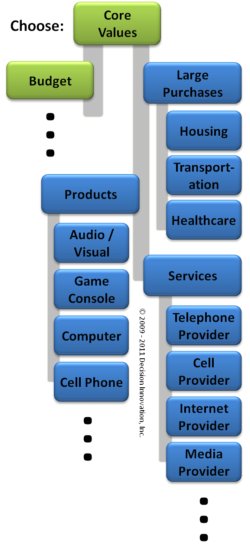Managed consumer decision making overcomes a vast number of choices
 Abundance of choice in today's world has become the new dilemma in consumer decision making. Just enter the shampoo isle in the local grocery store or retailer and you face a wall of decisions. How many ways are there to wash one's hair? Do I need to know what type of hair I have: dry; oily; normal; ...? What scent should I pick? Is my hair damaged or not? Why does one shampoo cost twice another shampoo? Which size should I buy?
Abundance of choice in today's world has become the new dilemma in consumer decision making. Just enter the shampoo isle in the local grocery store or retailer and you face a wall of decisions. How many ways are there to wash one's hair? Do I need to know what type of hair I have: dry; oily; normal; ...? What scent should I pick? Is my hair damaged or not? Why does one shampoo cost twice another shampoo? Which size should I buy?
If I head into that aisle without some reduction of choices, I could easily spend 30 minutes and still not know which shampoo to buy. Assuming a $6 purchase, I should not be spending more than 6 cents of effort, or about 20 seconds of my time. Out of frustration, even when I would like to consider trying something new, I often end up picking the same shampoo I have always selected. Even knowing the product I want, it could easily take 5 minutes to find my preferred product when faced with this wall of choices.
How involved should you be?
Have you made this consumer choice before? If you had a good experience previously, it is likely that choosing the product again will be a good, or, at least, an adequate choice. Does this mean it is the best choice? Perhaps not, but when you consider your effort and cost to make the decision, satisficing may start to look like an optimal consumer decision making strategy, particularly for low value decisions.
As decision value and risk of a wrong decision increase, the buyer decision process should include additional effort to frame the decision and allow time to search for information that will improve decision quality. Take advantage of opportunities where the cost of gathering information is low to improve the worth of lower value decisions. This could include making a test purchase to gain direct experience, especially when the cost of purchase is very low and it's not worth your time to return it.
Develop strategies that can improve the buyer decision process
 Building a network of connected decisions can help the consumer decision making process. For example, choices on personal values can be used as a focusing decision to help eliminate certain alternatives and reduce the analysis effort. Certainly a choice to live close to family and friends will constrain the choice of what houses you might buy. A budget decision should influence how much will be spent on any product purchase.
Building a network of connected decisions can help the consumer decision making process. For example, choices on personal values can be used as a focusing decision to help eliminate certain alternatives and reduce the analysis effort. Certainly a choice to live close to family and friends will constrain the choice of what houses you might buy. A budget decision should influence how much will be spent on any product purchase.
Given the vast number of consumer choices, we will provide decision strategies and tools that can be applied across a range of decisions, and we will demonstrate their use with specific purchase decisions.
Return often as we add to our consumer decision library decisions that demonstrate strategies to overcome today's over abundance of choices.
Make a Digital Camera Selection
Decide how you will use your pictures before making a digital camera selection.
Perform a Game Console Comparison
Do a thorough game console comparison before making a decision.
High value consumer decisions
Explore the consumer decision process using the Consumer Expenditure Survey.
Housing decisions and implications for related consumer choices.

